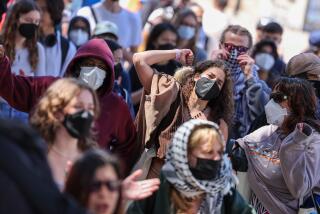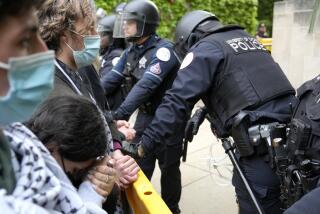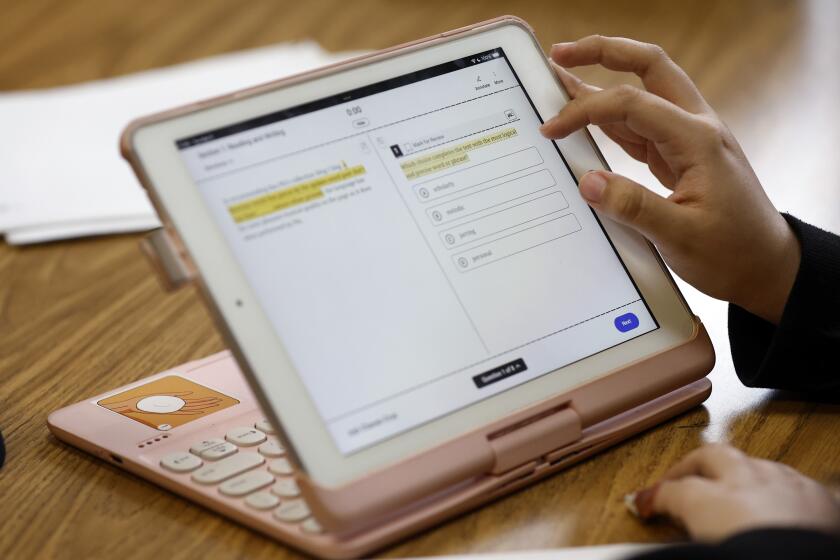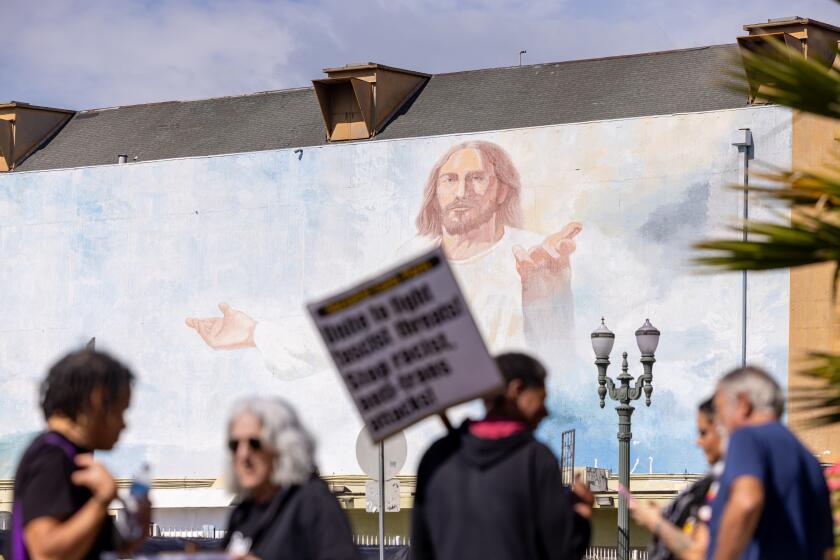Opinion: Today’s protests are tamer than the campus unrest of the 1960s. So why the harsh response?

Critics of the recent student protests have often erred by comparing them to the mass demonstrations against the Vietnam War that rocked U.S. college campuses more than half a century ago. In terms of size and disruptiveness, there is really no comparison. Today’s student movement against the Gaza War is far smaller and much less disruptive than the campus antiwar protests of the 1960s. So why has it drawn such an aggressive response?
College presidents who witnessed the massive, fiery student demonstrations of May 1970 — the peak month of antiwar protest in the Vietnam era — would have thanked their lucky stars if the protests on their campuses back then had been as nonviolent and tactically tame as they have most often been this semester.
Gaza protests across the U.S. are showing unprecedented support for Palestinians, and demanding accountability like never before.
Sparked by student fury at President Nixon’s announcement expanding the war by invading Cambodia, in early May 1970 30 ROTC buildings were torched or bombed. By the end of the month, militants had engaged in 95 acts of arson and bombing on campus. The National Guard had been called out to quell student protests in 16 states, one of which was Ohio, yielding the Kent State massacre, in which guardsmen killed four unarmed students and wounded nine others at an antiwar protest. Major antiwar demonstrations spread to more than 1,300 campuses, mobilizing an estimated 4 million students, more than half the American college student population. This included 350 student boycotts of classes and shut down some 500 colleges and universities.
By contrast, the protests this semester have, according to recent counts, involved more than 50 campuses, generally mobilizing student protesters in the hundreds rather than the thousands. There has been only a handful of building takeovers, limited use of civil disobedience and an absence of bombings, arson and student strikes.
Yet police have been called in to suppress nonviolent encampments on such campuses as USC, New York University, the University of Virginia, the University of Texas and Columbia University, with more than 2,600 arrests nationally. While in the 1960s it usually took the takeover of university buildings, major property damage or violence to call in riot-clad police, in 2024 students have been arrested for minimally disruptive acts such as occupying outdoor campus spaces, including lawns and plazas.
The contrast makes it impossible to escape the conclusion that the U.S. and some of its most influential college and university leaders today are less respectful of student free speech rights and much quicker to use police force to suppress student protests than they were in the Vietnam War era. What happened?
Less than 24 hours after a violent attack on a pro-Palestinian camp at UCLA, officers pulled apart barricades as they tore down the encampment and made arrests.
Student protest movements have always been unpopular with the American public, owing to our society’s cultural conservatism — its notion that students should respect their elders, shut up and study. The anti-Gaza war student movement’s romantic embrace of Palestinian nationalism makes it especially easy to demonize as pro-Hamas, antisemitic and championing intifada violence against Israel.
So the movement has been immensely unpopular with cagey university administrators, trustees, some wealthy donors and politicians, many of whom have used their wealth and power not just to advocate but also to enforce the suppression of the movement. Toward the end of last year, amid campus tensions over the war in Gaza, pressure from billionaire donors and Congress cost the presidents of Harvard and the University of Pennsylvania their jobs, sending a brash message about who gets to dictate university environments.
While the suppression of radical or youth-led movements is not new, current efforts have an unprecedented heavy-handed, public and shameless quality. As California’s governor, Ronald Reagan did use disgraceful rhetoric against the student movement of the 1960s, as when he said “If it takes a bloodbath, let’s get it over with. No more appeasement.”
Jewish collective trauma, like that of the Palestinians, is undeniable. One shouldn’t have to go to Treblinka to be reminded of this.
But Reagan acknowledged the norms of university autonomy enough to engineer the firing of liberal UC president Clark Kerr in private, in an attempt not to publicly politicize the issue. Compare that with Speaker of the House Mike Johnson’s recent trip to Columbia University to urge its president to resign for not doing enough to suppress the movement against war in Gaza, even after her eviction order had led to the arrest of more than 100 student protesters.
If the trend is for administrators to call the police as a first rather than last resort, this tendency is reinforced by the increasingly hierarchical, centralized, undemocratic nature of university governance and decision-making.
On my campus, and many others, faculty are not typically consulted in presidential decisions to arrest protesters. Students have little to no meaningful role in shaping university policy and often lack even a token representative on the board of trustees, leaving them disenfranchised. It’s no wonder many find demonstrations the only way to make their views heard. And their university president tends to be a remote figure most students have not met; when a president orders mass student arrests, she’s imposing them on virtual strangers.
Police helmets and zip ties are never going to convince students to moderate their rhetoric and build a more inclusive antiwar movement. Such rethinking can only come from dialogue, trust and community building, all of which are short-circuited by college presidents, donors and politicians when they treat some of their campus’ most idealistic, politically engaged students — who on my campus slept outside in the rain to protest the Gaza war — as if they were criminals.
Robert Cohen is a professor of history and social studies at New York University.
More to Read
A cure for the common opinion
Get thought-provoking perspectives with our weekly newsletter.
You may occasionally receive promotional content from the Los Angeles Times.









